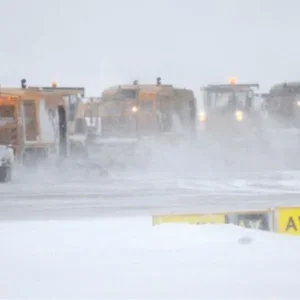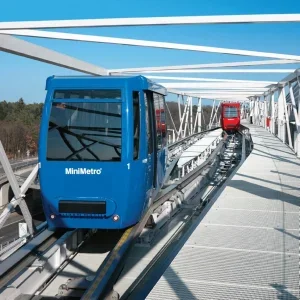There’s no doubt that the latest snow-clearing equipment is essential for effective winter airport operations. Since chaos engulfed a snowbound Heathrow in late 2010, the airport has spent tens of millions of pounds on sweepers, gators, tractors, ramp hogs and other specialised vehicles.
Oslo Airport Gardermoen, which experiences far more severe weather than Heathrow, and far more often, also has its stable of leading-edge machines, such as the giant Øveraasen TV 2200 snowblower. But even though these vehicles are indispensible, Oslo Airport CEO Nic Nilsen puts his airport’s incredible winter record down to excellent planning and communications, rather than to any particular technological edge.
"Norway being located where it is geographically, handling winter conditions is part of the culture here," says Nilsen. "You have to concentrate on planning, procedures, resources and training – lots of training."
Opening in 1998, Oslo Airport was planned with winter operations in mind from the very start, with four de-icing platforms and ample snow storage areas. Over the last 15 years, Nilsen and his team have developed, and constantly updated, a set of procedures governing every aspect of snow removal.
Timelines, ploughing guidelines and techniques, where and when to deposit chemicals on runways prior to snowfall, contact information, procedures for closing runways and staff assignments: all these are essential elements of the formal procedures. The plans conform to the relevant sections of Aviation Regulations issued by Norway’s Civil Aviation Authority and the European Aviation Safety Agency, encompassing lines of communication, equipment availability, airline schedules, friction testing and safety practices.
"All the procedures we use were developed in close cooperation with the airport’s air traffic management," says Nilsen. "The main objective is to have a safe situation when it comes to friction conditions. At the same time, we want to minimise the time we close the runway for."
Snow clearance is split into three phases. Phase one aims to keep the runway open and operational at all times, and involves removing snow from the two runways, taxiways and exits as long as the snow is falling.
The vital figure here is 15 minutes – that’s the maximum time a single runway can be closed in order to maintain normal flight operations. This timing means that a plane will be on final approach 13-14 minutes after runway closure for snow-clearing, landing just after it reopens. Oslo Airport exceeded the 15-minute deadline just once last season.
In phase two, other parts of the system are closed in agreement with the tower in order to clean instrument landing system (ILS) equipment, signs, roadways, intersections and lights.
"In phase three, we focus on bringing the airport back to a stable situation, transferring all the snow away to the snow deposit areas," says Nilsen.
Phase one takes an hour and 40 minutes, while phase three can last up to a week. Different versions of the procedures fit in with the direction of the airport’s two parallel runways.
Experience the difference
During the winter season, which runs from the middle of October until the beginning of April, the airport employs around 100 temporary staff for snow-clearing operations. Full-time and seasonal employees are divided into four teams, which means there are always 27 staff available at any time, no matter whether it snows or not.
A separate airside contractor collects snow removed from runways and trucks it to the snow deposit area. A crew of mechanics is always on hand in case any snow-clearing vehicles break down. As the machines can work 24 hours continuously, both the mechanics and spare vehicles are essential elements of the strategy.
Each snow-clearing team has a foreman directly in charge of the operation. It is a critical position held only by experienced, full-time employees. The duty manager of airfield services is in charge of the teams, and is always in close communication with the tower, as are the foremen.
"If there is a lot of snow and they have to clear a runway, the duty manager will communicate with the tower and see when it is convenient to close the runway," explains Nilsen. "If the tower gets a report from a pilot saying that an area is slippery, for instance, then they will pass that to the duty manager."
Knowing the precise route that each person and vehicle should follow is key to efficient operations and safety; in low visibility, it’s even more important.
"That underlines the importance of everyone knowing where they have to be and being disciplined in adhering to the procedures," says Nilsen. "We have a multilateration radar system and the controllers monitor the operations on radar at all times so they know exactly where each vehicle is."
Like a mechanised ballet, sweepers and snowblowers must hold their formation precisely in order to clear runways quickly and effectively. Driver training is, by necessity, rigorous and learning on the job is not an option. To help refine procedures and to use as a training aid, Oslo has developed a computer simulation of snow-clearing operations.
"Before each season, we go through the procedures with the crews, including temporary staff," explains Nilsen. "We only have five to ten new staff each season, as it’s very popular to come back, but they can be a little rusty if they have been away for six months. We give them a classroom update and take them airside, where we go through all the procedures on a dry airport in cooperation with the tower."
During the winter season, Nilsen runs weekly weather briefings, where his team meets with airlines and other operators at the airport to discuss the expected weather conditions over the coming seven days.
"They have to be sure that they have all resources to hand: do we have enough de-icing liquid, do we have enough staff, are all the vehicles up and running?" he says.
De-icing techniques
There are many other details encoded in Oslo’s winter procedures, such as de-icing routines. For cost and environmental reasons (the airport sits on top of a large aquifer, part of which is designated as drinking water), Oslo seeks to minimise the amount of glycol it uses during its everyday operations.
To do this, a technique for de-icing called Proportional Mixture is used. The airport’s de-icing crews mix hot water with varying amounts of glycol depending on the temperature. "We now save a lot of glycol by doing that," says Nilsen.
He emphasises that it’s not enough for just the airport operator to be prepared – the whole airport community, from pilots and pushback operators to fuelling and catering outfits, must all be properly equipped and trained if winter operations are to run smoothly.
"Anyone can delay an aircraft, so they have to have equipment with winter tyres or a pushback tractor that is heavy enough to move the aircraft when there is snow or a little bit of ice," he says.
With this kind of focus, it’s no wonder that the aviation world beats a path to Oslo’s door to learn more about how they do it. However, having a global reputation as experts on winter conditions experts sometimes means knowing your limits.
Extreme operations
Situated inland, Oslo has to deal with freezing rain and fog as well as snow, and even the biggest snowblower is powerless to cope with this extreme weather. On 14 December 1998, the first severe freezing rain since the airport opened destroyed 13,737 engines.
Once again, Oslo has developed procedures to cope with even these conditions. Engines are pre-heated and shielded to keep them as hot as possible, while aircraft have to run up their engines periodically while taxiing, letting the airport stay open, but at a reduced capacity.
"We learned a lot from that and we are not as exposed as we used to be," says Nilsen. "But sometimes it is better to close for an hour or two."
Constantly updating its procedures, while investing in training and top-line equipment, means Oslo is ready to face whatever the harsh winter throws at it. The airport has closed only twice in the last 15 years due to snowfall, proving that its methods work efficiently and consistently.
"A snowfall to us is a normal operation," concludes Nilsen. "It is something we are prepared for and train for, and when it snows, we deal with it."






